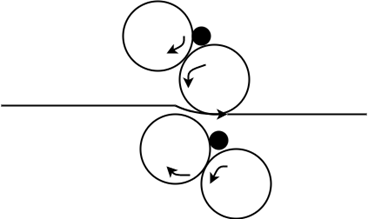This set of Engineering Materials and Metallurgy online quiz focuses on “Vulcanization and Forming of Rubber, Adhesion Process and their Types”.
1. How much sulfur must be added to rubber for vulcanization?
a) 1-5%
b) 7-20%
c) 25-35%
d) > 40%
View Answer
Explanation: The optimum quality of rubber is achieved when 1 to 5 parts of sulfur are added to 100 parts of rubber. The material becomes hard and less extensible when this proportion is increased.
2. What is the tensile strength of vulcanized rubber?
a) 10 kg/cm2
b) 70 kg/cm2
c) 700 kg/cm2
d) 105 kg/cm2
View Answer
Explanation: Vulcanization of rubber drastically improves the strength of a rubber. Vulcanized rubber exhibits a tensile strength of about 700 kg/cm2 and an elongation at break of 800%. Unvulcanized rubber has a low tensile strength of around 70 kg/cm2.
3. ________ is the process of spreading sheets of compound over a fabric.
a) Compression molding
b) Extrusion
c) Calendering
d) Vacuum forming
View Answer
Explanation: Calendering is a forming operation by which rubber compounds are spread like sheets over a fabric. The calendering unit involves three to five rolls in different combinations.
4. Which of these is not an ln operation of calendering?
a) Sheeting
b) Frictioning
c) Skim coating
d) Buffing
View Answer
Explanation: Sheeting involves the production of long and continuous sheets of a rubber compound. These sheets are then mechanically pressed from a thin layer to a sheet of fabric. Skim coating is the application of a thin sheet of rubber to the sheet of fabric.
5. Warming up of a compound and feeding it to an extruder is the operation of _________
a) Tubing
b) Tumbling
c) Buffing
d) Trimming
View Answer
Explanation: Tubing is the most economical and widely used method of rubber preparation. Here, the compound is heated in a mill and then inserted directly into the extruder. The extruder is also known as a Tubing machine. This extrudes the rubber of the desired shape and size.
6. Which operation does the following figure portray?

a) Calendering
b) Milling
c) Extrusion
d) Trimming
View Answer
Explanation: This figure illustrates the arrangement of the rolls, fabric, and coating material for calendering. Here, the arrangement is a Z-type 4-roll calendar extending on both sides.
7. Injection molding uses a _________ for unvulcanized rubber.
a) Geneva mechanism
b) Screw mechanism
c) Dwell cam
d) Linkage
View Answer
Explanation: A screw mechanism is used to force the rubber into a tightly closed mold. This force, under high pressure, increases the temperature and reduces the time required.
8. Epoxy adhesives are widely used in _________
a) Carpentry
b) Plastics
c) Glasses
d) Steel
View Answer
Explanation: Epoxy adhesive is a copolymer made of a resin and a hardener. They have a faster curing rate and are used for quick fixes. These adhesives possess good resistance to heat, chemicals, and creep.
9. Araldite glue is primarily used in ________
a) Plastics
b) Automobile parts
c) Textile
d) Leathers
View Answer
Explanation: Araldite glue is a common adhesive used to join small and lightweight metals. It is extensively used by automobile companies like Audi, Bentley, and even Lamborghini.
10. _________ glue is used for curing with water.
a) Epoxy
b) Polyamide
c) Silicone
d) Polyurethane
View Answer
Explanation: Polyurethane glues when in contact with moisture result in speedy curing of materials. They are primarily used are woodworking adhesives. Gorilla Glass is a widely used Polyurethane adhesive.
11. Dendrite is used as a ________ adhesive.
a) Contact
b) Hot
c) Reactive
d) Pressure sensitive
View Answer
Explanation: Dendrite acts as both an adhesive and a cement brand. Contact adhesives are used in applications involving strong bonds with great shear resistance. These are applied to two surfaces, left to dry for a while, and they are made to contact each other.
12. Blu Tack is used as a ________ adhesive.
a) Contact
b) Hot
c) Reactive
d) Pressure sensitive
View Answer
Explanation: Blu Tack is a common pressure sensitive type of adhesive used on surfaces to attach lightweight objects. Pressure sensitive adhesives, as the name suggests, form a bond on the application of pressure.
13. Animal glue, epoxy, and polyurethane are examples of ________
a) Spray adhesives
b) Fabric adhesives
c) Super Glue
d) Wood glues
View Answer
Explanation: Wood glue, as the name suggests, is an adhesive used to join wood pieces and materials together. Along with the above-mentioned types, wood glues include urea-formaldehyde, cyanoacrylate, and polyvinyl acetate among others.
14. ________ is defined as the amount of time that any product can be used once it has been opened.
a) Aging
b) Permeation
c) Shelf life
d) Transmission rate
View Answer
Explanation: From the time that a product or service is opened for use till the time it retires is recorded as its shelf life. In common terms, shelf life is known as the expiration date.
15. How is the shelf life of cyanoacrylate when unopened?
a) 10 days
b) One month
c) One year
d) Lifetime
View Answer
Explanation: Cyanoacrylate is an adhesive belonging to the wood glue family. These are commonly used in household and medical applications. This adhesive has a short shelf life of one year if unopened and of one month once it has been opened.
Sanfoundry Global Education & Learning Series – Engineering Materials & Metallurgy.
To practice all areas of Engineering Materials and Metallurgy for online Quizzes, here is complete set of 1000+ Multiple Choice Questions and Answers.
If you find a mistake in question / option / answer, kindly take a screenshot and email to [email protected]
- Check Metallurgical Engineering Books
- Practice Metallurgical Engineering MCQs
- Apply for Metallurgical Engineering Internship
- Check Engineering Materials Books
